Fire adaptations
Fire adaptations are life history traits of plants and animals that help them survive wildfire or to utilize resources created by wildfire. These traits can help plants and animals increase their survival rates during a fire and/or reproduce offspring after a fire. Both plants and animals have multiple strategies for surviving and reproducing after fire.
Plant adaptations to fire
Unlike animals, plants are not able to move physically during a fire. However, plants have their own ways to survive a fire event or recover after a fire. The strategies can be classified into three types: resist (above-ground parts survive fire), recover (evade mortality by sprouting), and recruit (seed germination after fire). Fire plays a role as a filter which can select for different fire response traits.[1]
Resist
Thick bark
Fire impacts plants most directly via heat damage. However, new studies indicate that hydraulic failure kills trees during a fire in addition to fire scorching. High temperature cuts the water supply to the canopy and causes death of the tree. Fortunately, thick bark can protect plants because they keep stems away from high temperature.[1] Under the protection of bark, living tissue won't have direct contact with fire and the survival rate of plants will be increased. Heat resistance is a function of bark thermal diffusivity (a property of the species) and bark thickness (increasing exponentially with bark thickness).[2] Thick bark is common in species adapted to surface or low-severity fire regimes. On the other hand, plants in crown or high-severity fire regimes usually have thinner barks because it is meaningless to invest on thick bark without it conferring an advantage in survivorship.[1]
Self-pruning branches
Self-pruning is another trait of plants to resist fires. Self-pruning branches can reduce the chance for surface fire to reach the canopy because ladder fuels are removed. Self-pruning branches are common in surface or low-severity fire regimes.[1]
Recover
Epicormic buds
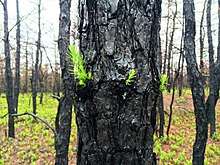
Epicormic buds are dormant buds under the bark or even deeper.[3] Buds can turn active and grow due to environmental stress such as fire or drought.[4] This trait can help plants to recover their canopies rapidly after a fire. For example, eucalypts are known for this trait. The bark may be removed or burnt by severe fires but buds are still able to germinate and recover. This trait is common in surface or low-severity fire regimes.[1]
Lignotubers
Not all the plants have thick bark and epicormic buds. But for some shrubs and trees, their buds are located below ground, which are able to re-sprout even when the stems are killed by a fire.[1] Lignotubers, woody structures around the roots of plants that contains many dormant buds and nutrients such as starch, are very helpful for plants to recover after a fire.[5][6] In case the stem was damaged by a fire, buds will sprout forming basal shoots. Species with lignotubers are often seen in crown or high-severity fire regimes (e.g., chamise in chaparral).
Clonal spread
Clonal spread is usually triggered by fires and other forms of removal of above ground stems. The buds from the mother plant can develop into basal shoots or suckers from roots some distance from the plant. Aspen and Californian redwoods are two examples of clonal spread.[1] In clonal communities, all the individuals developed vegetatively from one single ancestor rather than reproduced sexually. For example, the Pando is a large clonal aspen colony in Utah which developed from a single quaking aspen tree. There are currently more than 40,000 trunks in this colony and the root system is about 80,000 years old.[7][8]
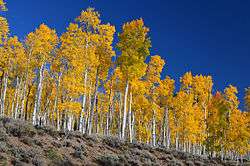
Recruit
Serotiny
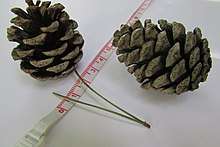
Serotiny is a seed dispersal strategy in which the dissemination of seeds is stimulated by external triggers (such as fires) rather than by natural maturation.[9] For serotinous plants, seeds are protected by woody structures during fires and will germinate after the fire. This trait can be found in conifer genera in both northern and southern hemisphere as well as in flowering plants families (e.g., Banksia). Serotiny is a typical trait in crown or high-severity fire regimes.[1]
Fire stimulated germination
Many species persist in a long-lived soil seed bank, and are stimulated to germinate via thermal scarification or smoke exposure.
Fire-stimulated flowering
A less common strategy is fire-stimulated flowering.
Dispersal
Species with very high wind dispersal capacity and seed production often are the first arrivals after a fire or other soil disturbance. For example, fireweed is common in burned areas in the western United States.
Plants and fire regimes
The fire regime exerts a strong filter on which plant species may occur in a given locality.[1] For example, trees in high-severity regimes usually have thin bark while trees in low-severity regimes typically have thick bark. Another example will be that trees in surface fire regimes tend to have epicormic buds rather than basal buds. On the other hand, plants can also alter fire regimes. Oaks, for example, produce a litter layer which slows down the fire spread while pines create a flammable duff layer which increases fire spread.[1] More profoundly, the composition of species can influence fire regimes even when the climate remains unchanged. For example, the mixed forests consists of conifers and chaparral can be found in Cascade Mountains. Conifers burn with low-severity surface fires while chaparral burns with high-severity crown fires.[10] Ironically, some trees can "use" fires to help them to survive during competitions with other trees. Pine trees, for example, can produce flammable litter layers, which help them to take advantage during the completion with other, less fire adapted, species.[1]
Evolution of fire survival traits
Phylogenetic studies indicated that fire adaptive traits have evolved for a long time (tens of millions of years) and these traits are associated with the environment. In habitats with regular surface fires, similar species developed traits such as thick bark and self-pruning branches. In crown fire regimes, pines have evolved into traits such as retaining dead branches in order to attract fires. These traits are inherited from the fire-sensitive ancestors of modern pines.[1] Other traits such as serotiny and fire-stimulating flowering also have evolved for millions of years.[1] Some species are capable of using flammability to establish their habitats. For example, trees evolved with fire-embracing traits can "sacrifice" themselves during fires. But they also cause fires to spread and kill their less flammable neighbors. With the help of other fire adaptive traits such as serotiny, flammable trees will occupy the gap created by fires and colonize the habitat.[11][12]
Animals' adaptations to fires
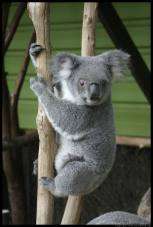
Direct effects of fires on animals
Most animals have sufficient mobility to successfully evade fires. Vertebrates such as large mammals and adult birds are usually capable of escaping from fires. However, young animals which lack mobility may suffer from fires and have high mortality. Ground-dwelling invertebrates are less impacted by fires (due to low thermal diffusivity of soil) while tree-living invertebrates may be killed by crown fires but survive during surface fires. Seldom, animals are directly killed by fires. Asphyxiation is believed the reason to kill animals during the Yellowstone fires of 1988.[1]
Long term effects of fires on animals
More importantly, fires have long-term effects on the post-burn environment. Fires in seldom-burned rainforests can cause disasters. For example, El Niño-induced surface fires in central Brazilian Amazonia have seriously affected the habitats of birds and primates.[13] Fires also make animals exposed to dangers such as humans or predators. Generally in a habitat previously with more understory species and less open site species, a fire may replace the fauna structure with more open species and much less understory species. However, the habitat normally will recover to the original structure.[14]
Animals and fire regimes

Just like plants may alter fire regimes, animals also have impacts on fire regimes. For example, grazing animals consume fuel for fires and reduce the possibilities of future fires. Many animals play roles as designers of fire regimes. Prairie dogs, for example, are rodents which are common in North America. They are able to control fires by grazing grasses too short to burn.[1]
Animal use of fire
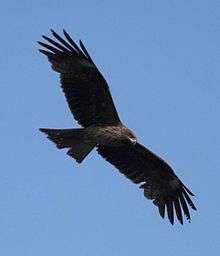
Fires are not always detrimental. Burnt areas usually have better quality and accessibility of foods for animals, which attract animals to forage from nearby habitats. For example, fires can kill trees and dead trees can attract insects. Birds are attracted by the abundance of food and they can spread the seeds of herbaceous plants. Eventually large herbivores will also flourish. Also, large mammals prefer newly burnt areas because they need less vigilance for predators.[1] An example of animals' uses on fires is the black kite, a carnivorous bird which can be found globally. Although it is still not confirmed, black kites were witnessed to carry smoldering sticks to deliberately start fires.[15] These birds can then capture the escaping insects and rodents.
Summary
Both plants and animals have multiple strategies to adapt with fires. What is more, both plants and animals are capable of altering fire regimes. Human knows how to use fires, and plants and animal "know" it as well.
See also
References
- 1 2 3 4 5 6 7 8 9 10 11 12 13 14 15 16 Scott, Andrew C.; Bowman, David M.J.S.; Bond, William J.; Pyne, Stephen J.; Alexander, Martin E. (2014). Fire on Earth : An Introduction. Chichester, West Sussex: Wiley-Blackwell. ISBN 9781119953562. OCLC 892138560.
- ↑ van Mantgem, Phillip; Schwartz, Mark. "Bark heat resistance of small trees in Californian mixed conifer forests: testing some model assumptions". Forest Ecology and Management. 178 (3): 341–352. doi:10.1016/s0378-1127(02)00554-6.
- ↑ "Glossary". www.anbg.gov.au. Retrieved 2017-11-12.
- ↑ Percival, Glynn. "EPICORMIC SHOOTS" (PDF). Retrieved 11 November 2017.
- ↑ C., Scott, Andrew. Fire on earth : an introduction. Bowman, D. M. J. S., Bond, William J., 1948-, Pyne, Stephen J., 1949-, Alexander, Martin E. Chichester, West Sussex. ISBN 9781119953562. OCLC 892138560.
- ↑ Paula, Susana; Naulin, Paulette I.; Arce, Cristian; Galaz, Consttanza; Pausas, Juli G. (2016-06-01). "Lignotubers in Mediterranean basin plants". Plant Ecology. 217 (6): 661–676. doi:10.1007/s11258-015-0538-9. ISSN 1385-0237.
- ↑ "Fishlake National Forest - Home". www.fs.usda.gov. Retrieved 2017-12-08.
- ↑ "Quaking Aspen - Bryce Canyon National Park (U.S. National Park Service)". www.nps.gov. Retrieved 2017-12-08.
- ↑ Lamont, Byron B.; Maitre, D. C. Le; Cowling, R. M.; Enright, N. J. (1991-10-01). "Canopy seed storage in woody plants". The Botanical Review. 57 (4): 277–317. doi:10.1007/BF02858770. ISSN 0006-8101.
- ↑ Odion, Dennis C.; Moritz, Max A.; DellaSala, Dominick A. (2010-01-01). "Alternative community states maintained by fire in the Klamath Mountains, USA". Journal of Ecology. 98 (1): 96–105. doi:10.1111/j.1365-2745.2009.01597.x. ISSN 1365-2745.
- ↑ Bond, William J.; Midgley, Jeremy J. (1995). "Kill Thy Neighbour: An Individualistic Argument for the Evolution of Flammability". Oikos. 73 (1): 79–85. doi:10.2307/3545728. JSTOR 3545728.
- ↑ Mutch, Robert W. (1970-11-01). "Wildland Fires and Ecosystems--A Hypothesis". Ecology. 51 (6): 1046–1051. doi:10.2307/1933631. ISSN 1939-9170.
- ↑ Barlow, Jos; Peres, Carlos A. (2004-03-29). "Ecological responses to El Niño–induced surface fires in central Brazilian Amazonia: management implications for flammable tropical forests". Philosophical Transactions of the Royal Society B: Biological Sciences. 359 (1443): 367–380. doi:10.1098/rstb.2003.1423. ISSN 0962-8436. PMC 1693330. PMID 15212091.
- ↑ Smith, Jane Kapler (January 2000). "Wildland Fire in Ecosystems Effects of Fire on Fauna" (PDF).
- ↑ "Birds of prey are starting fires DELIBERATELY to smoke out mice". Mail Online. Retrieved 2017-12-08.